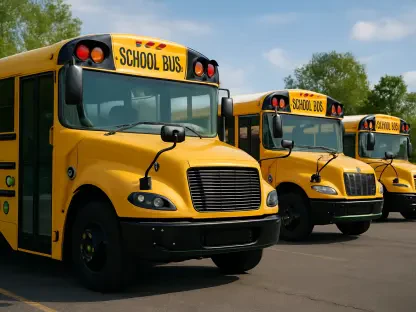The United States is on the brink of a significant demographic shift that will impact the number of high school graduates in the coming years. This change is expected to have far-reaching consequences for higher education institutions, policymakers, and the broader workforce. Understanding these trends and preparing for their implications is crucial for ensuring the sustainability and success of higher education.
Anticipating the Decline
Historical Context and Projections
Since 1979, the Western Interstate Commission for Higher Education (WICHE) has been analyzing demographic trends to forecast the number and demographic composition of high school graduates. The latest “Knocking at the College Door” report highlights that the U.S. will reach a peak in high school graduates this year, followed by a prolonged decline starting from 2025. This forecast is based on data from births, enrollment patterns, and state-specific graduation statistics.
The significance of these projections lies in their potential to influence the planning and allocation of resources within higher education. For policymakers and college administrators, understanding the upcoming decline is not merely about numbers but also about the strategic adjustments required to adapt to changing demographics. By 2030, the number of high school graduates is expected to decrease by approximately 3.1% from 2023 levels, a trend that emphasizes the need for proactive planning. Further down the line, by 2041, the decline will be even more pronounced, with about 3.4 million graduates, representing a 10.5% decrease from 2023. This gradual but significant decline will necessitate ongoing adaptation by educational institutions and policymakers to manage resources effectively and serve diverse student populations.
Projected Numbers and Trends
The anticipated decline in high school graduates stems from a range of factors, including historical birth rates, student progression rates, and regional migration and mortality trends. This forecast underscores a broader demographic shift and challenges educational institutions to rethink their long-term strategies. The “broad and substantial” nature of the projected decline means that a steady, concerted effort will be essential for mitigating its impact.
Educational institutions will need to closely monitor these trends to adjust their recruitment, retention, and resource allocation strategies. The planning must be both flexible and innovative, ensuring that they remain responsive to evolving student demographics. By implementing targeted initiatives to improve student retention and success, institutions can strive to maintain enrollment levels despite the shifting landscape. It is imperative to adopt a forward-looking approach, acknowledging that the demographics of the student population will continue to evolve, necessitating continuous evaluation and adaptation of strategies.
Regional Variations in Graduate Numbers
State-Specific Impacts
The projected decline in high school graduates will not uniformly impact all states or regions. While 38 states are expected to experience decreases, 12 states and Washington, D.C., will see increases. Notably, states like South Carolina, Tennessee, Idaho, and North Dakota will experience double-digit growth in high school graduates. Washington, D.C., is projected to witness a significant rise of 31%. These disparities highlight the importance of considering regional and state-specific factors when crafting educational policies and strategies.
For states facing a decline, it may be necessary to explore new recruitment strategies and partnerships to attract students from other regions or internationally. Conversely, states experiencing growth must be prepared to accommodate the increasing demand for higher education. Institutions in these areas may need to expand their capacity, develop new facilities, and ensure that their programs align with the evolving needs and expectations of a diverse student body. The differing trajectories among states serve as a stark reminder that a one-size-fits-all approach will not suffice, and tailored solutions must be devised to meet local demands and challenges.
Regional Differences
Regionally, the South will be the only area to see an increase in high school graduates, growing by 3% to about 1.5 million graduates by 2037. This contrasts with the decline in the Northeast (17%), Midwest (16%), and West (20%). The South’s higher projections could be partially attributed to population migration, although this cannot be definitively confirmed. These regional variations underscore the need for region-specific policy responses and institutional adaptations.
The pronounced decline in the Northeast, Midwest, and West emphasizes the necessity for targeted interventions in these regions. Institutions in these areas may need to explore innovative programs and partnerships to attract and retain students. Additionally, it becomes crucial to understand the underlying factors driving these regional differences, such as economic conditions, population trends, and educational preferences. By aligning their strategies with regional characteristics, higher education institutions can better navigate the challenges posed by the demographic shift, ensuring continued access to high-quality education for students across the country.
Urban, Suburban, and Rural Distributions
Suburban Growth
The geographical origin of high school graduates within states—categorized into suburbs, cities, towns, and rural areas—plays a key role in understanding demographic shifts. Suburbs, already housing the largest share of 12th-grade students at 43% in the 2022-2023 academic year, are projected to increase their share to 45% by 2033-2034. This equates to an additional 32,450 12th graders, highlighting the growing importance of suburban areas in the educational landscape.
The rise in suburban high school graduates will likely necessitate enhanced infrastructure and resources to support the growing student population. Suburban schools and higher education institutions may need to expand their facilities, improve transportation systems, and develop new programs that cater to the unique needs of suburban students. Additionally, these areas could see changes in housing, community services, and local economies as they adapt to accommodate the increasing number of students. Understanding and addressing these shifts will be vital for ensuring that suburban students receive the quality education and support they require.
Urban and Rural Trends
Conversely, cities’ shares are expected to decline from 31% to 29%, while rural areas will see a slight increase from 15% to 16%. The share of graduates from towns is predicted to remain steady at 11%. These shifts indicate that educational institutions in urban and rural areas may need to adapt their strategies to address changing student demographics and ensure continued access to quality education.
Urban schools and colleges may face challenges related to maintaining enrollment levels and addressing the specific needs of a shrinking student population. This might involve reallocating resources, reevaluating academic programs, and strengthening community partnerships to attract and retain students. In rural areas, the slight increase in high school graduates suggests the need for targeted support and investment to capitalize on this growth. Ensuring that rural students have access to the same quality of education as their urban and suburban counterparts will be essential for promoting equity and success across all regions.
Ethnic and Racial Shifts
Decline in Certain Demographics
The ethnic and racial composition of future high school graduates is another critical aspect of WICHE’s projections. The numbers of White, Black, American Indian, and Alaska Native graduates are expected to decline from 2023 to 2041. This trend reflects broader demographic changes and highlights the need for targeted support and resources for these student populations. Addressing the specific needs of these groups will be crucial for ensuring their continued success in both high school and higher education.
Educational institutions must prioritize creating inclusive environments that support the academic, social, and emotional needs of all students. This may involve developing programs tailored to the unique experiences and challenges faced by different racial and ethnic groups. Additionally, fostering a culture of diversity, equity, and inclusion within schools and colleges will be essential for promoting a sense of belonging and achievement among all students. Addressing disparities in access to resources and opportunities is key to supporting these diverse student populations effectively.
Growth Among Hispanic and Multiracial Graduates
In contrast, Hispanic graduates will steadily increase, growing by 16% over the same period. The most dramatic growth will be seen among multiracial graduates, whose numbers are projected to nearly double by 2034. This increasing diversity within the high school student population underscores the importance of creating inclusive and supportive educational environments that cater to the needs of all students. Embracing this diversity can foster a richer learning experience and prepare students for a globalized world.
Higher education institutions must develop strategies to support the growing number of Hispanic and multiracial students effectively. This includes providing culturally responsive teaching, enhancing support services, and promoting representation within faculty and staff. Institutions should also engage with communities to understand the unique needs and aspirations of these students, ensuring that their educational pathways are designed to facilitate success. By embracing and celebrating the increasing diversity of the student population, educational institutions can create a more inclusive and dynamic learning environment that benefits all students.
College Enrollment Rates
Declining Enrollment Trends
Beyond the raw numbers of high school graduates, college enrollment rates are pivotal in determining higher education’s financial health and sustainability. The college-going rate has declined significantly over the past decade, dropping from 70% in 2016 to 62% in 2022. Economic health prominently influences this rate, with college attendance typically rising during economic downturns. However, the recent decline suggests that factors such as rising tuition costs, concerns about student debt, and changing perceptions of the value of a college degree are playing a significant role.
Addressing these concerns is crucial for reversing the trend of declining college enrollment rates. Educational institutions and policymakers must work together to make higher education more accessible and affordable. This could involve exploring new financial aid models, enhancing support services, and promoting alternative pathways to higher education. By demonstrating the tangible benefits of a college degree and addressing the financial barriers that deter prospective students, institutions can encourage more individuals to pursue higher education and achieve their academic and professional goals.
Potential for Increased Enrollment
The WICHE authors suggest that even a modest increase in college enrollment rates could offset the projected decline in high school graduates. A hypothetical 0.5% uptick in the college-going rate could lead to higher college enrollments in 2041 compared to 2024. This projection underscores the potential impact of enhancing college attendance rates and the importance of making higher education more accessible and appealing to prospective students.
To achieve this, institutions must prioritize initiatives that improve student retention and success. This includes implementing programs that support at-risk students, providing academic advising and career services, and fostering a campus culture that promotes engagement and belonging. Additionally, outreach efforts targeting underserved populations and non-traditional students can help diversify and expand the student body. By adopting a holistic approach to addressing the factors influencing college enrollment rates, higher education institutions can work towards ensuring a bright future for their students and the broader society.
Policy Implications and Future Adaptations
Strategic Planning and Adaptation
The impending decline in high school graduates, coupled with evolving demographic patterns, necessitates strategic planning and adaptation by policymakers and higher education leaders. These stakeholders have the opportunity to develop comprehensive, forward-thinking strategies that address the multifaceted challenges posed by demographic shifts. The focus should be on long-term, sustainable solutions rather than temporary fixes, ensuring that educational institutions can effectively serve a changing student demographic.
One key strategy is to improve college-going rates through targeted outreach and support programs. This includes initiatives aimed at increasing access for underserved populations, enhancing financial aid opportunities, and promoting the value of higher education. Additionally, institutions should focus on improving retention and progression rates for students who enter college. By providing robust academic and support services, colleges can help students navigate their educational journey successfully and achieve their academic goals.
Enhancing Access and Success
WICHE President Demarée Michelau emphasizes that demographics need not dictate destiny, and proven methods exist to increase student access and success, especially for underserved populations. Policymakers and educational leaders must leverage existing best practices and innovative approaches to create inclusive learning environments that cater to diverse student needs. This includes fostering partnerships with K-12 schools, community organizations, and employers to create seamless educational pathways and support transitions to higher education.
Furthermore, addressing the broader workforce challenges associated with the decline in high school graduates will be essential for ensuring the sustainability of higher education institutions. Aligning educational programs with workforce demands, promoting skills development, and fostering lifelong learning opportunities can help bridge the gap between education and employment. By adopting a holistic approach that integrates education, workforce development, and community engagement, policymakers and educational leaders can create a resilient and adaptable higher education system that meets the needs of all students and the broader society.
Conclusions
The United States is approaching a significant demographic shift, which will greatly affect the number of high school graduates in the coming years. This impending change is set to have substantial implications for higher education institutions, lawmakers, and the broader workforce. As the size and makeup of high school graduating classes fluctuate, colleges and universities will need to adapt their recruitment and retention strategies to maintain enrollment numbers and financial stability.
These demographic trends will also demand that policymakers craft new strategies to support educational institutions and ensure they remain inclusive and accessible. In addition, the broader workforce may see shifts in the availability of educated labor, impacting various sectors of the economy. Consequently, it is imperative for educational leaders and policymakers to closely examine these trends and proactively devise plans to address the myriad challenges and opportunities posed by the shifting demographic landscape. By doing so, they can secure the sustainability and success of higher education, benefiting society as a whole.









